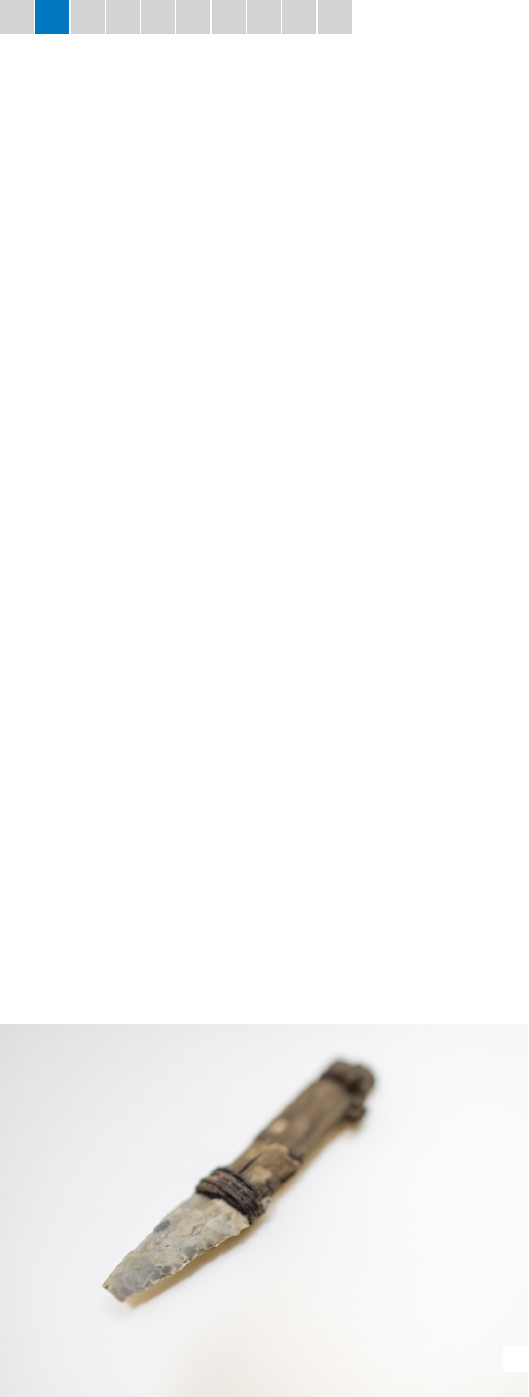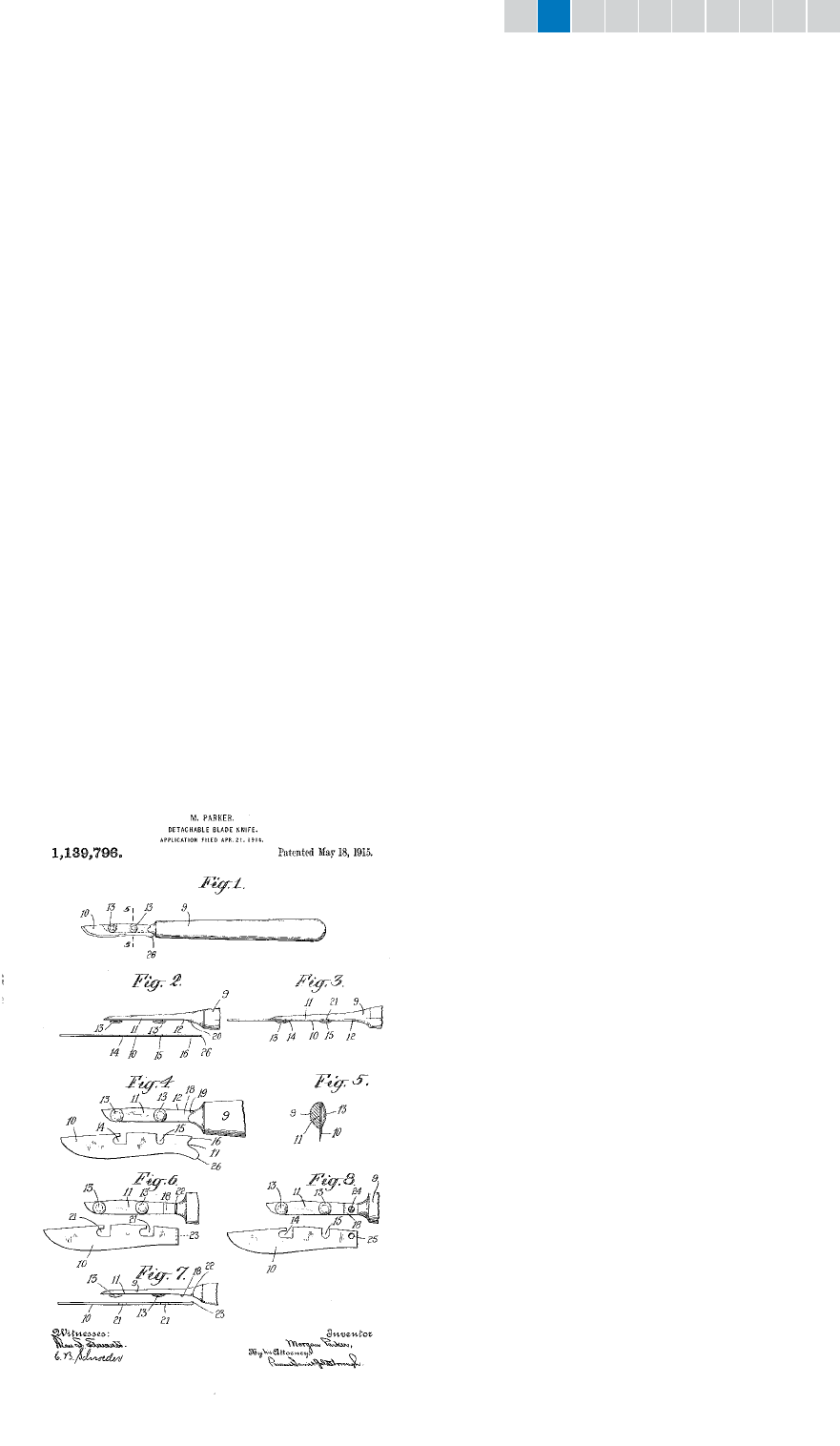
CC2017 Poster Competition • The history of the scalpel: From flint to zirconium-coated steel •
13
© 2017 by the American College of Surgeons. All rights reserved.
10987654321
AUTHORS
Jason B. Brill, MD
Evan K. Harrison, MD
Michael J. Sise, MD, FACS
Romeo C. Ignacio, Jr., MD, FACS
CORRESPONDING AUTHOR
Jason B. Brill, MD
Residency in General Surgery
Naval Medical Center
San Diego, CA
2
The history of the scalpel:
From flint to zirconium-coated steel

CC2017 Poster Competition • The history of the scalpel: From flint to zirconium-coated steel •
14
© 2017 by the American College of Surgeons. All rights reserved.
10987654321
The surgical knife, one of the earliest surgical
instruments, has evolved over 10 millennia.
While the word “scalpel” derives from the Latin
word “scallpellus,” the physical instruments
surgeons use today started out as flint and
obsidian cutting implements during the Stone
Age. As surgery developed into a profession,
knives dedicated to specific uses also evolved.
Barber-surgeons embellished their scalpels
as part of the art of their craft. Later, surgeons
prized speed and sharpness. Today’s advances
in scalpel technology include additional safety
measures and gemstone and polymer coatings.
The quintessential instrument of surgeons,
the scalpel is the longstanding symbol of the
discipline. Tracing the history of this tool reflects
the evolution of surgery as a culture and as a
profession.
Origins
Pinpointing a specific period of time when a cutting implement
became the first surgical knife depends largely on perspective.
Shells, razor-like leaves, bamboo shoots, and even fingernails
may all be viewed as early surgical instruments. Thumbnails
for newborn circumcisions, scarification via plant stems, and
venesection with sharks’ teeth served as the first examples
of sharp tools for procedures on the human body.
1,2
John
Kirkup, MB, BS—a retired surgeon and honorary curator of
the Historical Instruments Collection at the Royal College of
Surgeons of England—researched the history of surgical tools
for more than 20 years.
3
According to Dr. Kirkup, circumcision
with sharpened stones, one of the earliest recorded elective
procedures, evolved into knives used for basic procedures.
4
Excavations of archaeological sites dating to the Paleolithic
and Neolithic periods revealed knives for surgical use as early
as 10,000–8,000 BC.
5
Blades were initially composed of flint,
jade, and obsidian, with specific pieces chosen for their sharp
edges. Fracture and flake techniques were then employed to
refine these early blades into cutting instruments with desired
characteristics, making these objects among the first human-
refined tools.
6
A particularly well-preserved prehistoric blade mounted onto
a handle was found in 1991, preserved in ice near the Austrian-
Italian border (see Figure 1). These types of tools were used
for scarification, venesection, lancing, and circumcision. In
fact, these instruments were still used for many of the same
purposes by Alaska Native tribes well into the 19th century.
7
Evidence of obsidian blades used for more complex procedures
such as craniotomies appeared around 4000 BC in prehistoric
Anatolia, modern-day Turkey. Some archeological specimens
are still sharp enough to incise skin.
8
1

CC2017 Poster Competition • The history of the scalpel: From flint to zirconium-coated steel •
15
© 2017 by the American College of Surgeons. All rights reserved.
10987654321
Transition to modern scalpels
Metal blades replaced sharpened stone: first it was copper
(3500 BC), followed by bronze and then iron (1400 BC). But
it wasn’t until 400 BC that the concept of a surgical knife was
first described by Hippocrates.
9
He used the term “macairion,” a
smaller version of a Lacedaemonian sword called a “machaira,”
to describe the surgical tool. The machaira was a broad-
cutting blade with a single edge and sharp point, containing
the same essential features of the modern scalpel as defined
by Stedman’s Medical Dictionary: “A pointed knife with a
convex edge.”
10,11
In Rome, Galen and Celsus used an instrument
with this shape—a small, sharp blade for specialized used for
incision and drainage, tendon repairs, and vivisections (see
Figure 2).
The Romans named their version of this tool the “scallpellus,”
the diminutive form of the word scalper (“incisor” or “cutter”).
12
With the collapse of the Roman Empire, surgical innovation
flourished in the Islamic Golden Age. Albucasis (Abū al-Qāsim
Khalaf ibn al-‘Abbās al-Zahrāwī, 936–1013) in the Caliphate of
Córdoba (modern Spain) used a scalpel that held a retractable
blade.
13,14
Surgical instruments became even more varied and
specialized with the Renaissance in the 14th and 15th centuries.
Embellishments to the scalpel included fixed and folding blades
and specialized tips, such as lancets, bistouries, and double-
edged blades called catlins.
Barbers working during the Renaissance period, including
fathers of modern surgery such as Guy de Chauliac and
Ambroise Paré, used ornamented scalpels with artistic
flourishes that enjoyed wide popularity for several hundred
years.
15
The requirements of antisepsis and asepsis in the late
19th century subjected instruments to caustic chemicals and
pressurized steam sterilization, so nonmetallic decorations
became obsolete (see Figures 3 and 4).
4
3
2

CC2017 Poster Competition • The history of the scalpel: From flint to zirconium-coated steel •
16
© 2017 by the American College of Surgeons. All rights reserved.
10987654321
Disposable scalpels
King C. Gillette founded the American Safety Razor Company
(later the Gillette Safety Razor Company) in 1901 to produce
and market a handle-and-frame device that held disposable
razors. John Murphy, MD, FACS, a Chicago, IL, surgeon and one
of the founders of the ACS, adapted Gillette’s razors into a tool
that could be used when performing surgical operations. Dr.
Murphy’s version featured interchangeable blades, although it
required extra instruments to complete a blade exchange.
16
In 1914, Morgan Parker, a 22-year-old engineer, invented the
two-piece blade-and-handle medical scalpel that is used in ORs
today.
10
It allowed rapid mass-produced, sharp blades to be
used and exchanged on standard reusable handles. According
to legend, Mr. Parker’s uncle, a New York, NY, surgeon, became
impatient with the cumbersome process of the blade exchange
in his busy practice. A glance at Mr. Parker’s elegant solution
reveals its genius (see Figure 5). He stated the following in his
original patent application:
For the purpose of securing the blade to the handle, headed studs
are preferably provided on the handle adapted to co-act with
suitable slots in the blade. When such headed studs and slot are
employed, the blade may be readily secured upon the handle and
when in position will be held so rigidly as to preclude the possibility
of movement relative to the handle.
17
When Mr. Parker presented his scalpel at the ACS Clinical
Congress of 1915 in Boston, MA, its reception encouraged
him to take it to production. Mr. Parker, an engineer but
not a businessman, sought a partner. The first name listed
alphabetically in the phone book under “medical suppliers” was
C.R. Bard. Together, they formed the Bard-Parker Company,
which became one of the iconic names in surgery. They
developed cold sterilization to avoid superheating, which killed
microorganisms, but also dulled the blade. The rib-back handle
replaced those that bore the paired studs in 1936 in order to
ensure one-way fitment between the blade and handle.
The numbering system of blades and handles is arbitrary, a fact
that likely confirms the suspicions of generations of surgical
interns. As part of the Bard-Parker marketing scheme, each
new blade and handle design was given a new number and
occasionally a letter that denoted a “new and improved” model
(for example, #15C).
18
As a result, a given number has no
relation to size, shape, sharpness, or even a place in the product
timeline.
Modern additions
In the modern era, hardened alloys, such as 316L and 440C
stainless steel, replaced carbon steel in most settings.
Stainless steel had superior corrosion resistance, and reusable
handles benefited most from the high chromium content of
stainless steel. Retracting blades, a concept dating to the
time of Albucasis of the 10th century, became an increasingly
common safety feature. Nickel and chromium plating became
less common. Recent technological improvements include
zirconium nitride, diamond, and polymer coatings that
enhance the cutting edge. For all the improvements evident in
contemporary surgical technology, electron microscopic images
actually confirm that the edge of Neolithic obsidian blades
exceed today’s steel scalpels in sharpness.
19
Conclusion
The scalpel, since its first use as a medical knife by the Romans,
has been a symbol of the surgeon. Its evolution in many
ways mirrors the progress of those wielding it. Prehistoric
humans used stone tools occasionally for medical uses. The
Greeks and Romans advanced both knowledge and skill while
creating dedicated surgical knives. The barber-surgeons
refined techniques as they refined the instruments used for
them. Asepsis mandated sweeping changes in both scalpel
and surgical practice. Today, the modern surgeon relies on
a wide array of technologically advanced and ever-changing
equipment, yet the operation still begins with the scalpel, the
profession’s oldest instrument.
5

CC2017 Poster Competition • The history of the scalpel: From flint to zirconium-coated steel •
17
© 2017 by the American College of Surgeons. All rights reserved.
10987654321
References
1 Scultetus J. The Chyrurgeon’s
Storehouse. London, UK:
Starker; 1674.
2 Pankhurst R. An historical
examination of traditional
Ethiopian medicine and
surgery. Ethiop Med J.
1964;3:157-167.
3 Kirkup J. The history
and evolution of surgical
instruments VI: The surgical
blade: From nger nail to
ultrasound. Ann R Coll Surg
Engl. 1995;77(5):380-388.
4 Jacobs MS. Circumcision. Ann
Med Hist. 1939;1(3):68-73.
5 Rezaian J, Forouzanfar F.
Consideration on trephinated
skull in the Sahre-e Sukte
(Burnt City) in Sistan. Res
Hist Med. 2012;1(4):157-168.
6 Moser L, Pedroti A. The
Neolithic settlement of
Lugo di Grezzana (Verona):
Preliminary report. In:
Belluzzo G, Salzani L, eds.
From Earth to Museum:
Exhibition of Prehistoric and
Protostorical Finds of the
Last Ten Years of Research
From the VeroneseTerritory.
Legnago, Italy: Fondazione
Foroni; 1996.
7 Ackerknecht EH.
Primitive surgery. Am
Anthropol.2009;49(1):25-45.
8 Shadbolt P. How Stone Age
blades are still cutting it
in modern surgery. CNN.
Available at: www.cnn.
com/2015/04/02/health/
surgery-scalpels-obsidian/
index.html. Accessed
November 10, 2017.
9 Adams F. The Genuine
Works of Hippocrates, Vol.
II. London, UK: Sydenham
Society; 1849.
10 Ochsner J. The surgical
knife. Bull Am Coll Surg
1999;84(2):27-37.
11 Stedman TL. Stedman’s
Medical Dictionary for the
Health Professions and
Nursing. Philadelphia, PA:
Lippincott Williams &
Wilkins; 2005.
12 Bliquez L. Tools of the empire.
In: The Tools of Asclepius:
Surgical Instruments in Greek
and Roman Times. Boston,
MA: Brill; 2015.
13 Elgohary MA. Al Zahrawi:
The father of modern surgery.
Ann Ped Surg. 2006;2(2):82-87.
14 Ahmadi SA, Zargaran A,
Mehdizadeh A, Mortazavi
SMJ. Remanufacturing and
evaluation of Al Zahrawi’s
surgical instruments, Al
Mokhdea as scalpel handle.
Galen Medical Journal
[online]. 2013;2(1):22-25.
Available at: www.gmj.
ir/index.php/gmj/article/
viewFile/42/27. Accessed
December 19, 2017.
15 Rutkow IM. On scalpels
and bistouries. Arch Surg.
2000;135(3):360.
16 Ochsner J. Surgical knife. Tex
Heart Inst J. 2009;36(5):441-
443.
17 Parker M. Detachable-
blade knife. U.S. Patent
US 1139796A. Available
at: http://pdfpiw.uspto.
gov/.piw?Docid=01139796.
Accessed December 19, 2017.
18 Arrow AK. Solving the
mystery of the scalpel
blades: What do the numbers
mean? Plast Reconstr Surg.
1996;97(4):861-862
19 Buck BA. Ancient technology
in contemporary surgery. West
J Med. 1982;136(3):265-269.
Legends
1 Flint dagger of Ötzi the Ice
Man. Image © South Tyrol
Museum of Archaeology/
Harald Wisthaler, Bolzano,
Italy.
2 Example of a Roman
scallpellus and similar
instruments. Courtesy of
Historical Collections &
Services, Claude Moore
Health Sciences Library,
University of Virginia,
Charlottesville.
3 Surgical set from the American
Revolutionary War. Displayed
in the Smithsonian National
Museum of American History,
the set includes wood and iron
handles and required routine
sharpening of the blades.
4 Detachable blades from
circa 1900. Courtesy of the
Royal College of Physicians
and Surgeons of Glasgow,
Scotland.
5 Morgan Parker’s original
patent. Source: United States
Patent and Trademark Ofce,
uspto.gov.
